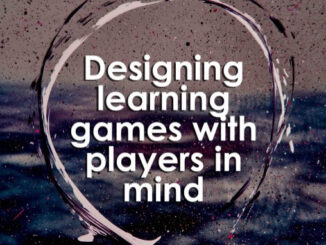
Bringing Collaboration into Play
Right now, gamification and games are so focused on online implementation that you could be forgiven for thinking they’re mainly about tech. But online is just one playing field, and tech is just one ball. There are others: face-to-face learning, workplace performance management, behaviour change in real-life situations.
If you look across them all, they’re all really about motivation. How we can hold games up to the light, see what makes people want to play, and apply it to elsewhere. In making new games or in making people want to do more of some things and less of others.
And there’s one constant across the many people out there picking apart what makes people motivated to do things in games or gamified systems: difference. Different things drive different people and players. One size never fits all.

Competition as a Default
But there is a default size when managers and decision-makers want to bring games, play and game-like elements into the workplace: competition. Points, awards and achievements, leaderboards. I’ve seen twenty sales leaderboards for every well-planned collaborative tool.
Here’s the problem: take the suggested game drivers from some of the most respected experts in the field of why games motivate, and plot whether they are more strongly associated with competition-focus, collaboration-focus, or neither.
Focusing on the left-hand column leaves swathes of drivers untouched.
The Issues with Competition
Let’s think about how that might look in practice. You implement a game or gamified system at work, designed to promote the behaviours you want, using a blunt leaderboard or other purely competition-focused method. You’re losing out because:
- You’re missing the chance to harness the non-competitive drivers
- You can weaken intrinsic motivation — studies have shown that when you reward behaviours people wanted to do anyway, it can make the behaviour less likely
- You may reduce confidence and engagement in the losers, or those off the pace
- You may increase conflict if people take it too seriously
- People can start to game the system, prioritising points over the team and the work
- It can trigger a threat response, even for the winners (who may protect their position)
- You de-incentivise collaboration, and aren’t helping people learn to work together
- You may see an overall performance improvement, but driven only by those who engage, which may paper over a performance drop in those who don’t
If there’s so much that’s bad about it, why is it the default? The word default reveals a lot here. Many defaults are not the best option when analysed carefully. But a quick-fix leaderboard is common, it’s easy to do, and it’s widely (lazily) supposed to motivate people.
Improving Competition
To be fair, not all competition-focused ventures are as bad as all that. As well as combining elements, game design is about careful design thinking and playtesting. Monopoly is an awful game because it has poorly designed elements (few meaningful choices, high luck factor, simple strategy), but also because it doesn’t factor in the player experience: what it feels like to troop round the board yet again when your opponent has six hotels and you have none.
So you don’t have to ditch competition. You could start by designing it better, and avoiding its negatives. You could:
- Make the competition intra-group instead of individual
- Reset the clock often so people never feel like they’re too far behind
- Have many metrics; somebody may be down on sales, but up on feedback scores
- Have metrics designed to give everyone something to aim for, e.g. biggest improvement
- Base leaderboards on levels instead of score, with careful structure to smooth progression up the levels, particularly early on
- Frame the whole thing well and put the ‘play’ into it; think about how you present its seriousness and its place in the workplace
- Pay attention to how people engage, and continuously improve the system to engage those who don’t buy in at first
- Make sure there’s no clash between the game and the work, or between the game and real-life concerns like pay and benefits
- Look beyond the competitive drivers and incorporate some from the other two columns
Bringing Collaboration into Play
And in particular, you could try to up the amount of collaboration you’re including in your design. You could:
- Measure and reward things that need and develop collaboration, like team projects, helping others, training and knowledge-sharing, and collaboration on new ventures
- Incorporate some kind of mentorship or buddying
- Give people opportunities to team up and achieve things together
- Let people give each other awards or structured positive feedback of some kind
- Measure against an average instead of absolutely, or against external organisations
- Allow the players to adapt or input to the design of the system or game over time
- Include qualitative feedback as well as quantitative
- Drop or downplay the idea that there have to be winners, that there is a ‘win’ state that can only be achieved by some
- Keep in mind the whole time how people are or aren’t enjoying it as a team
Even one or two of these could nudge your engagement levels and impacts in the right direction. Defaults, though, stay defaults a lot longer than they should. It takes proactive action to change things for the better. Why not start now?
- Review competition-focused play in your organisation, and remove or change elements that drive it towards negative impacts
- Assess which drivers your organisation taps into with games and playful systems and adapt them to tap into non-competitive drivers, particularly collaboration
- Look for opportunities to create new play, games and systems in your organisation using the ideas in this article
- Using Games to Sculpt Agency - 22nd November 2022
- Gift Horse Download - 25th April 2022
- Dungeons & Dragons & Development - 21st April 2022





A really great piece on the underpinnings. Thanks.
So many executives think that competition within an organization is a key to success. So they structure things for winning, failing to realize that if 10% are Winners, then 90% are Losers. Your writing clarifies this nicely and succinctly.
Why? My theory after nearly 50 years of observing people and performance boils down to my belief about selection. Of a group of 10 people, the top performer is selected to be “supervisor.” Of a group of 10 supervisors, the top performer is selected to be “manager.” Of a group of 10 managers, the top performer is selected to be “district manager” or some such title. This continues onward and upward until the Very Top Person is selected from a tiny cross-section of those who are probably the most competitive people in the organization. Thus, how odd that they view competition is a key issue of success. And, they think everyone else wants to compete in every and all things.
Organizations need to focus on collaboration so that “interdepartmental collaboration” is no longer an oxymoron in their cultures. Ya think?
I’m wondering, as I read this, and your comment, Scott, and I’m sure there must be some research on this somewhere, if there is a gendered perspective on this. My (purely anecdotal) experience of facilitating games for learning is that not only are the most competitive souls in the room, usually male, but also that there is quite a lot of peer pressure, from other males, that the ‘correct’ response when faced with a game situation, is to behave as competitively as possible. I gave even seen on some ocassions, a reluctance, or even blank refusal, to engage in playful activities which are more collaborative in nature, simply because there is ‘no way to win’.
that kind of attitude would be quite worrying in a organisational setting, as personal ‘success’ if it is only seen in terms of ‘winning’ could be highly incompatible with any number of organisational aims.